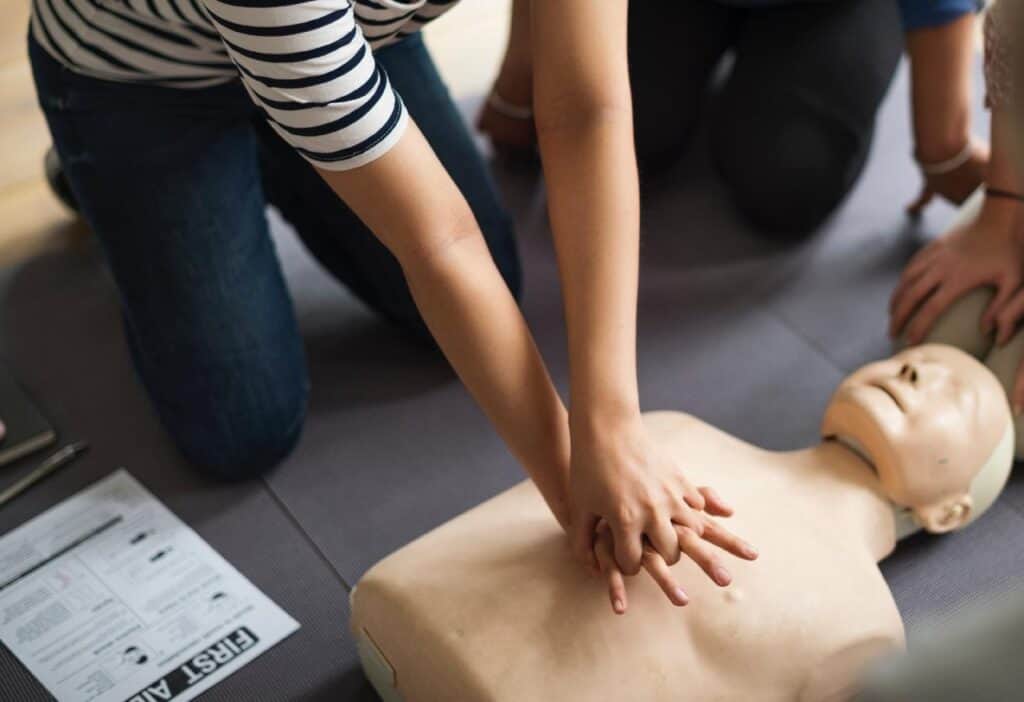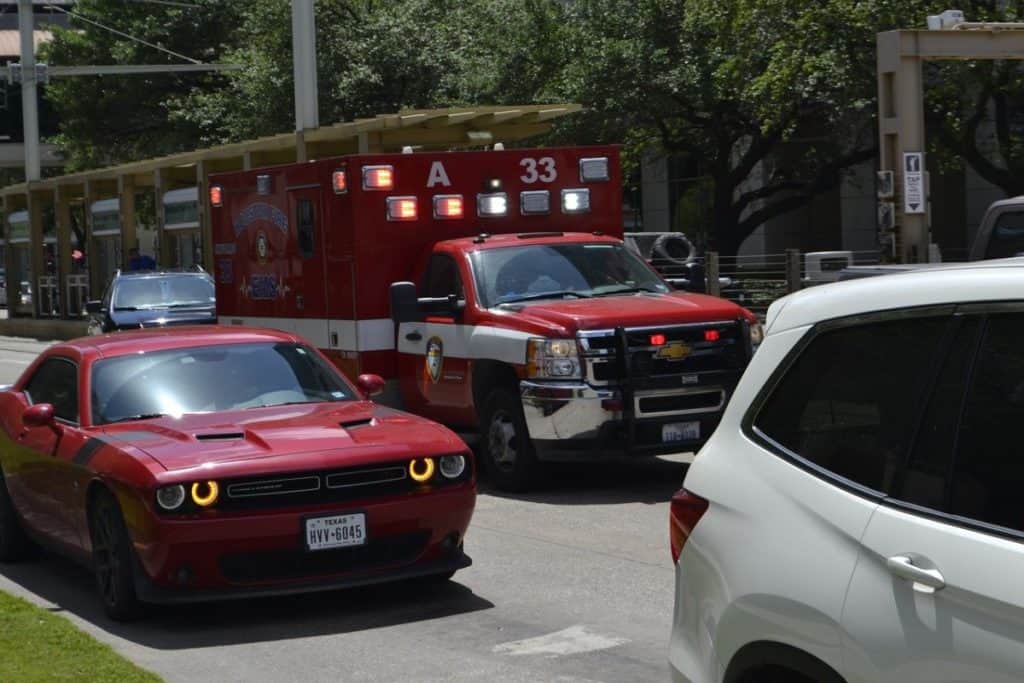If you’re new to giving CPR then you’ll probably want to make sure that you’re doing it properly and one area of confusion is the maximum interval that you can pause for when providing chest compressions. We’ve got the definitive answer for you.
During CPR chest compressions, the maximum interval for pausing chest compressions is 10 seconds. This is enough time to ventilate (breath for the patient), check for a pulse, and defibrillate before resuming chest compression cycles.
In this article we will cover the basics of CPR (cardio pulmonary resuscitation), why it is important to limit any breaks or pauses in chest compressions, as well as compression depth for different patients. Check it out.
Note: The info in this article gives some good information about CPR and how effective it can be. However, I can’t teach you CPR in an article, you must register for an accredited CPR class for that.
Your # 1 priority is keeping your family safe. As a firefighter, I recommend everyone has updated smoke detectors that don’t require battery changes, like these ones from Kidde, a fire extinguisher, like this one from Amerex, and a fire escape ladder if you have bedrooms above the first floor, I recommend this one from Hausse.
Also read: 7 Reasons Firefighters Show Up At Medical Emergencies
What Is CPR?

CPR stands for cardiopulmonary resuscitation.
Those are some pretty big and intimidating terms that represent the technique of saving someone’s life when their heart suddenly stops beating.
CPR is no joke, research says that if you can provide someone with effective CPR at the moment that their heart stops – you can double or possibly even triple their chances of surviving!
In the United States alone, nearly half a million people die because they go into cardiac arrest – each year! So, being able to deliver CPR is a hugely important life skill, in fact, if everyone was trained in CPR, there would be tens of thousands of people who would live that currently pass away when their heart stops.
CPR is a vital step in the process of saving lives – it is meant to keep the patient’s blood flowing (and thus oxygen moving around their system) which prevents organ damage and allows trained medical staff to have a better chance of being able to revive the individual.
It is the second step in the chain of survival defined by the American Heart Association (the full chain is defined as):
- Call for help – dial 911 and get emergency help
- Give CPR
- Provide rapid defibrillation (to get the heart started again) when available
- Paramedics perform additional services (ALS)
- The patient receives ongoing care
To learn more about the science (physiology) of CPR, watch this video:
When Are Chest Compressions Indicated?
OK, it’s very important to realize that you don’t just do CPR on everyone that looks like they might be in some distress.
CPR is indicated when the patient is:
- Unconscious – they should not be able to open their eyes
- Unresponsive – when you call their name or lightly tap their skin, they do not respond either verbally or with physical reactions
- Not breathing – sometimes they may be taking quick gasping breaths (agonal respirations or “guppy breathing”) but these are not effective and they should still get CPR.
There are then 5 steps to perform prior to delivering chest compressions:
- Check the area for any dangers. Why has this person’s heart stopped? Have the been bitten by a snake? Electrocuted? Are they high or drunk? Could anything here be a hazard not just to the patient as well as you or just to you? Never put yourself in danger to give CPR. Move any hazards or move the patient as gently as possible, if you can.
- Check the victim for a response. Give them a bit of a gentle shake, then shout at them (to try and wake them up, not to scold them) and see if you can get a response.
- Call for help. You need to phone for an ambulance (911 in the US). CPR can only help while you wait for an ambulance, they have the tools to get the victim’s heart started again.
- Then open up the airway. It’s fine to turn the victim onto their back if needed for this. Tilt the head back then try to open the mouth and peek inside. If it’s full of fluid or other obstructions– turn them onto their side and remove it. Do this fast. You want to get onto CPR quickly now.
- Check their breathing. Be careful to ensure that the person is not breathing at all before you move on to CPR.
How Are Chest Compressions Performed?
OK, then it’s on to the chest compressions and they’re done like this:
- You place the heel of your hand on the bottom of the victim’s breastbone
- Then the other hand goes over the first, you can either interlock fingers or just grasp your own wrist
- You then compress to a level of no less than 2” and no more than 1/3 of the depth of the person’s chest
- If you don’t want or can’t offer mouth-to-mouth this should be done at 100 to 120 compressions per minute
- If you are going to offer mouth-to-mouth then you want to deliver 30 compressions at the same rate (100 to 120 per minute) followed by two breaths. Remember, the maximum pause in compressions to ventilate should last no more than 10 seconds
- To get the right beat for compressions you can imagine you’re listening to the Bee Gee’s “Staying Alive” and match it.
- You may break someone’s ribs delivering compression like this, that’s OK – the alternative is their death.
This video from the American Heart Association shows the proper technique for Hands-only (no mouth to mouth breathing) on an Adult:
Why Is Allowing Complete Chest Recoil Important When Performing High-Quality CPR?
The rate of CPR provided is based around the idea that the chest needs to fully recoil each time a compression is delivered.
This should allow more blood to flow back into the heart with each compression.
How Does Complete Chest Recoil Contribute To Effective CPR?
If chest recoil isn’t allowed to take place, the heart will not get enough viable blood flow.
That means that you must ensure that the chest is compressed effectively and then allowed to return to normal before completing the next compression.
Ideal Depth Of Chest Compressions For A Newborn?
Newborns do not need CPR applied in the same way as you give it to an adult. You use this process, instead:
- Lie the child on its back. Don’t try to adjust the angle of their head or chin.
- Give gentle mouth-to-mouth by covering their mouth and nose with your own mouth
- Then use just two fingers on the lower half of the breastbone to give chest compressions to a depth of no more than 1/3rd of the child’s chest depth
- You use the same rhythm as you use for an adult’s CPR (100 – 120 compressions per minute)
This is to ensure that you do not damage the baby when you provide CPR. Newborns are far more fragile than adults and heavy CPR might even endanger the child’s life.
This doesn’t mean, however, that CPR is any less essential.
This video shows the technique for performing CPR on an Infant:
If you find a baby is not breathing, you want to give CPR – you just need to afford a little more care than you do to an adult.
How Do You Perform Chest Compressions When Providing High-Quality CPR To A Child Victim?
You also treat children under the age of 8 slightly differently when it comes to CPR.
- You want to use the heel of only one hand for chest compressions and not use two hands
- Give chest compressions to a depth of no more than 1/3rd of the child’s chest
- You use the same rhythm as you use for an adult’s CPR
As with babies, children are, until about the age of 8, a little more delicate than adults too and thus, we use a technique that is half-way between that used on babies and that on adults.
Here is a video that shows you the proper technique for CPR on a child:
Again, giving CPR is always more important than not if the child is unconscious, unresponsive, and not breathing.
Conclusion
In CPR: the maximum interval for pausing chest compressions is 10 seconds. This is an established recommendation based on the need to maintain blood flow to the heart during a cardiac arrest.
Remember that CPR is a life-saving technique. Everyone should learn it as it would make the world a safer place for everyone.
Related Articles:
Do Firefighters Have to Be Paramedics or EMTs?

